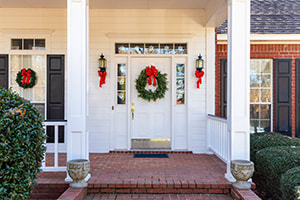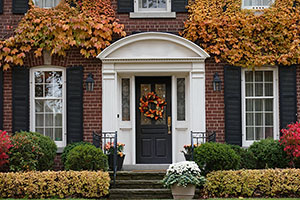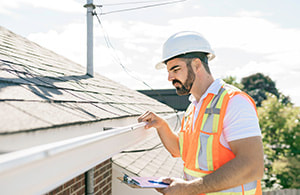 Owning a home is part of the American dream, but during the exciting process of making a purchase, don’t overlook important structural components. It’s natural to gravitate toward a visually beautiful home that has eye-catching elements such as granite kitchen countertops, a large fireplace, an attractive patio, or a well-landscaped yard. These attractive parts of the house stand out, but what you don’t notice can end up becoming costly liabilities. So, what are the big things you need to look for? Use the following list to avoid expensive repairs that will drain your bank account after closing. As a professional real estate agent, I can recommend a home inspector to check out the following structural components. Roof A roof covers and protects the entire structure of your home, so ensuring it’s in good condition is important. A home inspection can determine if there are torn or damaged shingles, rotting underlayment, or other problems. When roof leaks are not repaired promptly, damage occurs to the attic and ceiling areas, mold and mildew grow, the structural integrity of the home is compromised, and electrical wires near the leak become a fire hazard. Roof problems also contribute to an increase in heating and cooling costs. Foundation A home is built on its foundation, which, if weakened or damaged, can cause serious structural problems. Some signs an inspector will look for include the following:
Old and drafty windows allow cold air to enter and heat to exit, resulting in higher heating and cooling bills. Security is also an issue with older windows; 24% of all burglars enter a home through first-floor windows. New windows have security locks and modern features to make breaking in a challenge for burglars. Cosmetic upgrades are inexpensive and home improvements can be made at any time, but these three structural components are the foundation of a home. Repairs to any of these items can be extensive and expensive. When house hunting, always have a home inspector check out the home before making your final decision to purchase.
0 Comments
 Interest rates are always changing, and it can be hard to predict when they’ll go up or down. Here are some ways higher interest rates have affected the housing market. A Balanced Market Home prices are still up compared to last year, but most experts agree that home prices have peaked and are starting to adjust in many markets. Ultra-low mortgage rates brought a large number of buyers into the market, which drove up property prices as buyers competed for available homes. The increasing mortgage interest rate has priced many buyers out of the market. With fewer buyers shopping for homes and inventory increasing in some markets, sellers are beginning to adjust their asking prices to help prospective buyers afford the monthly interest and principal. Less Competition Buyers bemoan the higher monthly payments and reduced budget that come with a high-interest rate, but the flip side of this is that it gives them more leverage in negotiations. The bottom line is that rising interest rates price more buyers out of the market and motivate investors to stay on the sidelines for now. This means that instead of going up against 10 offers, buyers have a chance of being first in line. More Negotiating Power Buyers who can afford to stay in the game have more ground to stand on. Gone are the days of waiving contingencies and inspections. When sellers are more motivated, buyers are able to make reasonable or reduced offers—and even negotiate credits or repairs. This is a huge change from the market frenzy that occurs with ultra-low interest rates. For the right buyer, now may be the perfect time to get into the market before interest rates rise further. Buyers, interest rates are much higher than the rock-bottom rates of the last few years, but they are still historically low. Now is the time to secure a skilled real estate agent to start shopping. Sellers, you can still get a good price for your home, but be prepared to make concessions, such as rate buy downs or even helping with closing costs.  The holidays bring family together. But when that family is gathering in your home, it can mean weeks of planning, prepping, and cleaning. Ensure your next houseguests have a comfortable stay with these practical tips. Restock and Refresh Your Fridge Spend more time with family and less time in the kitchen by meal prepping for your guests. Make a few dinner dishes that are ready to go in the oven or already precooked. Stock up on breakfast foods, easy-to-grab snacks, and beverages. The temperature of your fridge shouldn’t go above 40 degrees to keep food safe from bacteria growth. Use a hot washcloth and vinegar to wipe down your fridge or place an opened box of baking soda at the back of the fridge to absorb odors. Clean Mattresses and Pillows Make your overnight guests feel well cared for by giving them everything they need for a good night’s sleep. First, freshen the mattress by sprinkling the surface with baking soda, letting it sit for 15 minutes, then vacuuming it. Clean the pillows by tossing them into the washing machine—but be sure to read the manufacturer’s directions first, as some pillows should not go into the wash. Make the bed with crisp sheets, and arrange some essentials on the bedside table—a glass and a carafe of water, some hand lotion, a candle or diffuser, a tissue box, and a good book. Bathroom Checkup Thoroughly clean the bathroom the day before guests arrive. Stock up on essential supplies—toilet paper, extra towels, soap, and unopened tubes of toothpaste—and arrange them in open baskets so guests can take what they need. And since an overflowing toilet can put a damper on any celebration, make sure you know where the water shut-off valve is and store a plunger nearby. Don’t Neglect the Hood Vent The kitchen gets lots of scrubbing over the holidays, but one surface that might need a cleaning is often neglected—the hood vent. This vent removes steam, smoke, and cooking odors from your kitchen. Its filter should be regularly cleaned. Some vent filters are dishwasher safe—check the manufacturer’s directions?but if not, a soak in mild detergent should remove grease and grime. Book a Fireplace Inspection A fire burning in a fireplace adds a cozy warmth to the holidays. However, not having a fireplace inspected prior to the cold weather season can be hazardous. Blocked chimneys on wood-burning fireplaces can cause chimney fires and create a deadly buildup of carbon monoxide in your home. This is a job best left to professionals. A professional chimney sweep can remove nests and debris from the chimney as well as inspect the flue to make sure it is in proper working order.  Fixer-upper homes are attractive for many reasons, including a lower sales price, less competition, and a relatively higher potential for resale profit. However, just like any other investment, there is risk involved in it. For one, fixer-uppers, which entail more added costs for repair and remodeling, can quickly become a bad investment. Avoid having your dream house turn into a nightmare by identifying the thin line between a fixer-upper and an outright bad investment. Condition | A fixer-upper requires mostly cosmetic improvements, while a bad investment requires both cosmetic and general structural improvements. Ideal fixer-uppers are those that need mostly cosmetic enhancements: paint jobs, floor refinishing, new lighting fixtures, and remodeled kitchen and bathrooms—everything that appeals to the eye. Certain structural improvements cannot be avoided, such as roofing, the heating and cooling system, and electrical wiring. On the other hand, a bad investment requires much more work, possibly to the structure or foundation, plumbing, or a terrible layout. These problems would require much higher costs than the amount you saved from buying it. Location | A fixer-upper is usually located in a desirable neighborhood, while a bad investment is on a busy street in an unsafe area. One of the strongest indications of a house’s market value is its location. Avoid buying fixer-uppers on a busy street, near a construction site, or in any other disruptive location. A wrong location for a fixer-upper significantly reduces your profit potential. Take note that you can improve only the house, not its position. After-Repair Appeal | A fixer-upper is a home everybody will love (and intend to buy) after you have made all repairs and renovation, while a bad investment is a house that, for some reason, nobody will want to buy, no matter how perfect it looks. There are numerous situations when a fixer-upper could be a bad investment. For example, few people want to buy a house with just two bedrooms in a neighborhood of mostly three- to four-bedroom homes. Or the problem could be location-related: The house may be near a river that overflows during heavy rains. The reason may also involve the layout, such as westward-facing windows that don’t get much sunlight. Avoid buying old houses with problems you cannot fix after a moderate renovation. A fixer-upper versus a bad investment could be hard to distinguish—consider the condition, location, and after-repair appeal. If you have questions about buying or selling real estate, reach out today!  In uncertain times, it’s natural to look for ways to ensure our financial security. One option that can provide peace of mind is investing in real estate. Here’s how real estate investing can help provide financial security. Buying and selling real estate to make a profit is one of the oldest and most reliable ways to build long-term wealth. Real estate investments can be as simple as buying a property and renting it out, or as complex as developing a property. The key to success in real estate investing is finding sound investment opportunities and making smart decisions. With the current market conditions, now is a good time to start thinking about buying real estate. Here are some of the benefits of owning and investing in real estate: • Real estate is a tangible asset that can be used as collateral for a loan. • Real estate is a stable investment that historically increases in value over time. • Real estate rentals can provide passive income to supplement your income or retirement savings. Investing in real estate allows you to build equity in an asset that can be used as a source of funding for other investments or life goals. You can tap into equity by taking out a home equity loan or home equity line of credit (HELOC). One of the reasons real estate makes a great investment is because it’s an easily accessible asset you can see and feel, unlike stocks or other investments. It also has a low correlation with the stock market, meaning it’s not as volatile. Another great thing about real estate is you can use it for your own enjoyment, such as staying at a vacation home you rent out for most of the year. Remember, real estate appreciation is a proven way to make money in the long run. When you invest in a property, you’re investing in yourself and your future.  There's nothing quite like sinking into a comfy seat with a mug of your favorite drink and making small talk with a good friend. If you’re looking to create a relaxing, cozy conversation area, consider these four ways you can transform your living room. Whether you have a studio apartment or a sprawling estate, these design options can accommodate any home. U-shape | In a traditional U-shaped conversation area, the three sides of the U are formed by sofas, love seats, settees, or armchairs. The open end of the U is reserved for the focal point, such as a stunning fireplace, television, or a large window. Try placing a large square ottoman in the middle of the U at equal distance between the furniture pieces. You’ll want to leave enough space to pass between each sofa, love seat, or chair—about 22 inches. End tables placed between two armchairs or other seating are a great option to hold table lamps, pots of greenery, or beverage containers. Square Configuration | For the square-shaped design, furniture seating takes up all four sides of the conversation area. For smaller homes, place two love seats opposite each other and two armchairs facing one another to create the square. Situate a large round coffee table in the middle of the conversation area to hold your reading materials, a vase of flowers, or electronic devices. Make sure the coffee table is at least 18 inches from each of the seats. Last, try adding two end tables diagonally across from each other between the love seats and armchairs to hold table lamps. Parallel Sofas | This arrangement is created by positioning two identical sofas across from each other; it’s an especially useful design if you want an open walkway at each end of the sofas. Situate an oval or rectangular coffee table between the two pieces of furniture, not extending more than two-thirds the length of the sofas. Avoid placing a centerpiece in the middle of the coffee table, which will block the view between the sofas. Substitute smaller love seats or settees to accommodate an area with limited floor space. L-shape | An L-shaped conversation area leaves a larger accessible area than the other furniture groupings, working well to make a room seem open and spacious. A sectional sofa is ideal for creating the L configuration, but you can also place a sofa and love seat next to each other to create the L-shape. The interior corner of the sectional sofa is a natural place for an oversized round ottoman. Situate a tray atop the ottoman as a convenient spot to place drinks or snacks. If you are floating the sectional in the middle of a room, leave a three-foot clearance for major walkways in your home. Consider these four furniture layouts to create a comfortable, fun conversation area in your home. Choose the grouping that best suits your personal preference and physical space to enjoy time with friends and family to the fullest.  For the sixth month in a row, existing-home sales declined, according to the National Association of Realtors (NAR). What’s more, every sales region in the country reported both month-over-month and year-over-year decreases. The drop in home sales was likely due to mortgage rates rising to 6% in early June. According to NAR Chief Economist Lawrence Yun, any decrease in mortgage rates would give an additional boost of purchasing power to homebuyers and help stabilize the market. Price Growth Slowing Another market indicator that could boost homebuyers is the peak of home selling prices appears to have passed. The median existing-home price in July increased 10.8% from a year earlier, with every sales region posting price gains. Though prices have seen year-over-year increases for the past 125 consecutive months, prices declined $10,000 from June’s record-high price of $413,800. Inventory Increasing The decline in home prices from June to July can partially be explained by an increase in supply. By the end of July, total housing inventory reached 1,310,000 units, up 4.8% from a month earlier and unchanged from a year earlier. At the current sales pace, this level of inventory would supply the market for 3.3 months, up from only 2.9 months in June and 2.6 months in July 2021. Though inventory may be starting to increase, Yun still sees signs of a housing recession in terms of declining home sales and home building. “However,” he added, “it’s not a recession in home prices. Inventory remains tight and prices continue to rise nationally with nearly 40% of homes still commanding the full list price.” Home Sales Declining Existing-home sales fell 5.9% from a month ago and 20.2% from a year ago. This drop in demand from homebuyers may result in some sellers being more motivated for a sale. Yet despite declining demand, properties sold in record time in July. The average property remained available for sale for just 14 days, unchanged from June and down from 17 days in July 2021. This set a record, as homes haven’t sold at a pace this quick since NAR began tracking days on market back in May 2011. Of all the homes sold in July, 82% were on the market for less than one month. Regional Breakdown Northeast: Existing-home sales annual rate of 620,000; a decrease of 7.5% from June 2022 and 16.2% from July 2021. The median sales price of $444,000 increased 8.1% from July 2021. Midwest: Existing-home sales annual rate of 1.19 million; a decrease of 3.3% from June 2022 and 14.4% from July 2021. The median sales price of $293,300 increased 7% from July 2021. South: Existing-home sales annual rate of 2.13 million; a decrease of 5.3% from June 2022 and 19.6% from July 2021. The median sales price of $365,200 increased 14.7% from July 2021. West: Existing-home sales annual rate of 870,000; a decrease of 9.4% from June 2022 and 30.4% from July 2021. The median sales price of $614,900 increased 8.1% from July 2021.  When applying for a mortgage, it’s important for would-be homebuyers to be aware of the factors, both positive and negative, that could affect their ability to get a loan. Any steps you can take to accentuate the positive and resolve negative financial issues will be a plus in the eyes of the potential mortgage lender. Positive Factors Some factors that may help you get the mortgage loan you need include:
Some things that could harm your chances of getting the mortgage you need include:
 In July, inflation numbers declined slightly to 8.5% from June’s 40-year high of 9.1%. Food, gas, and clothing have all become more expensive, yet salaries haven’t increased at the same pace, leaving gaps in monthly budgets. Households have felt the strain of elevated prices. In times of economic uncertainty, many people will hold off on making large purchases. However, unlike purchasing a car or electronics, which start to depreciate in value seconds after the purchase, buying a home is an investment. Here’s why home ownership can help reduce the rising costs that come with inflation. Homeownership Helps Stabilize Monthly Budgets The cost of shelter accounts for a large portion of monthly expenses. During times of high inflation, home prices and rent can both increase, reducing the amount left over for expenses like groceries, gas, and savings. While home prices may be rising, purchasing a home is often the more affordable option than signing a rental lease. Here’s why: Rent can increase on a yearly basis, while homebuyers who have locked into a fixed-rate mortgage will be paying the same monthly payments throughout the duration of the loan, usually 15 to 30 years. This helps keep budgets in check. In addition, salaries and wages often rise over time, making mortgages more affordable. Homeowners who locked into their fixed-rate mortgages a decade ago are often paying less per month than renters, leaving more money for other expenses. Homeowners Can Expect a Steady Home Appreciation Home prices have soared over the last few years, which means it’s more expensive to buy a home today than it was a year ago. The short supply of homes for sale, combined with high demand from buyers, caused prices to skyrocket. That raging price growth has since slowed down, and the price of homes is expected to moderate over the coming years. Since the 1970s, average home price appreciation has outperformed the average inflation rate in most decades. When you invest in a home, you can expect its value to increase steadily over time. High inflation and rising costs can make homebuyers question the timing of their purchase. Some buyers might be waiting to see if housing prices will decline, but that scenario is unlikely. Experts predict price growth slowing, but don’t expect a sharp drop in prices. Other homebuyers may be holding off to see if mortgage rates drop, but the current rates?although higher than the rock-bottom rates of the last few years?are still quite low. Buyers, if you need expert advice on planning your next move, reach out today! I can find you a home that fits your needs and is a smart investment. Buying real estate is still one of the most stable investments a person can make, especially during a time of high inflation.  Buying a home is a big investment that is accompanied by risk. Minimizing that risk is as simple as arranging for an inspection of the home to ensure that everything is working properly. A thorough inspection of these areas is important before buying or selling a home. Electrical inspections are very important. Making sure a home’s electrical system is safe can’t be overstressed. This task involves looking at the circuit breakers, house wiring, and outlets. If anything does not meet existing electrical codes, repairs will be needed. Heating and cooling are an integral part of keeping your home’s temperature regulated and comfortable. The entire system is evaluated, including the heater, AC unit, chimney, duct system, and fireplace (if there is one). Roof inspections identify existing structural damage caused by a leaky roof and provide information about necessary roof repairs or even a roof replacement. Such an inspection typically includes a look at the flashing, downspouts, and gutters to ensure everything is in good condition. Plumbing inspections assess the integrity of the water lines, sewage lines, faucets, toilets, sinks, tubs, showers, and water heater. This inspection identifies leaks, misalignments, and other issues that should be corrected and verifies that the plumbing meets local and state codes and ordinances. Air quality is important for your health. Toxic substances present within a home will affect the air quality. Some toxic substances to screen for include radon, asbestos, mold, mildew, lead, and fungus. Many of these substances can aggravate existing health issues or even cause new health problems. Pest infestations, particularly large ones, can cause structural damage. Before buying a home, you should hire a specialist to check for pests such as termites, carpenter ants, carpenter bees, mice, squirrels, bats, and raccoons. Your real estate agent can help you find a qualified home inspector. Since states have rules about the parts of a house that must be inspected prior to sale, you may need to specifically request additional inspections for items not included on this list. |
AuthorBe informed with the latest real estate news and useful real estate related information. Archives
March 2025
Categories
|
